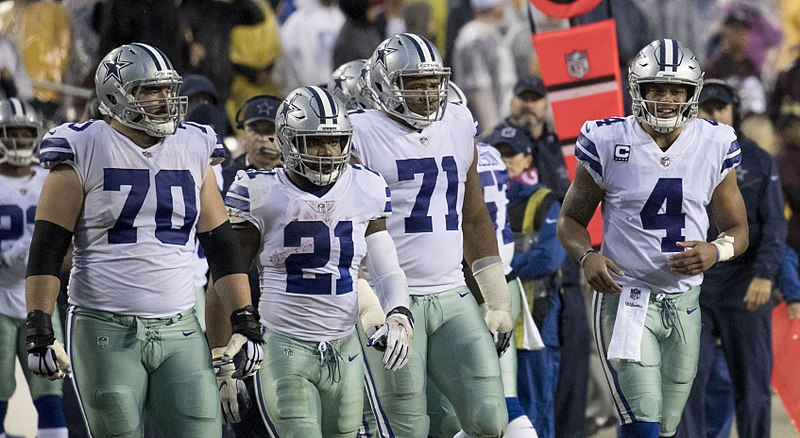Finally, the Dallas Cowboys’ Jason Garrett Era mercifully ended in January. Jerry Jones, after a sleepover (literally), tapped Mike McCarthy to replace the Clapper-in-Chief in Dallas. We still must take a look back at that which was in Dallas in 2019. What happened that we need to remember for America’s Team’s players for the upcoming 2020 fantasy football season?
What to Remember from the 2019 Dallas Cowboys Season
- Quarterback Dak Prescott had some high highs and some low lows, as Football Absurdity Co-Founder Evan Hoovler experienced first-hand on the podcast. As a Dak owner, Evan exposed himself to the ups-and-downs of Dak’s season. The lows were low (Dak had one or zero touchdowns five times this year), but were never sustained. Each quarter of Dak’s season had just one zero touchdown game. Each quarter of the season produced a great per-game stat line, with the worst (309 passing yards, 1.5 touchdowns, 1.3 interceptions per game) mostly due to a three-pick effort against the Packers.
- Amari Cooper started the season hot, topping 100 yards and/or scoring a touchdown in six of his first eight games. He then had 147 receiving yards in his ninth game, but this wasn’t enough to stem his second-half downturn. In the last eight games of the season, Cooper had just 488 receiving yards, and he did not pass 92 receiving yards in a game once. In fact, and this pains me, Randall Cobb had more receiving yards in the second half of the season than Amari Cooper. Cooper injured his knee in week thirteen but did not miss time. Ultimately, that injury just gives “Amari Cooper is a fantasy football WR1” acolytes more cover for 2020.
- Randall Cobb spent eight years in Green Bay, and never had a season with a yard per catch over 15. Last year, he slew that beast and posted a monstrous 15.1 yards per catch. Obviously, that’s a joke, but his 55.2 yards per game marked his first foray over that mark since 2015 and marked his highest total since his 80.4 yards per game in 2014. Cobb didn’t make a lot of noise, but he did outgain Amari Cooper in the second half. He has his former coach in tow, who knows how to utilize Cobb properly. Keep that in mind for your 2020 drafts, as Cobb is a decent late-round sleeper candidate. This is especially true if Amari Cooper bolts for greener (moneywise) pastures.
- I will admit that I thought Jason Witten’s departure from ESPN for the Dallas Cowboys was a soft-firing by ESPN. I thought he worked it out with the network to save face for his truly terrible Monday Night Football performances. Jason Witten proved me wrong. He ended the season as top-twelve TE, technically a starting-caliber fantasy football tight end. Was he actually that good? Well, not really. Despite his end-of-season rank, Witten posted just one top-five week and five top-ten weeks. He never had any real consistency, but he played all sixteen games and ended up ranked there by default. All three of his top-eight games this season came with touchdowns, the “gimme” weekly top-eight TE freebie. He wasn’t good for fantasy football, so don’t let his year-end rank fool you in 2020.
- What happened to Ezekiel Elliott? The 2018 RB5 absolutely cratered his value in 2019, finishing as the… RB4. Yep. That’s right. Elliott, despite the sound and fury that he didn’t live up to expectations, finished higher than he did in 2018. Of the big four in fantasy football drafts, he and CMC finished inside the top-four at the position, while Alvin Kamara and Saquon Barkley did not. A high touchdown total on the year ensured a top-four slot for Zeke since he carried a 0% bust rate all year. At worst, he finished as RB22 on the week. This happened twice, in weeks ten and sixteen, so Zeke might have left owners with a bad taste in their mouth.
Check out the rest of the What to Remember series as it develops!
For more football with a dose of absurdity, follow Football Absurdity on Twitter.
Get free fantasy football advice by joining our Discord.
Header Image Source: https://upload.wikimedia.org/wikipedia/commons/6/6f/Dallas_Cowboys_vs_Redskins_2017_%282%29.jpg under CC BY-SA 2.0)




